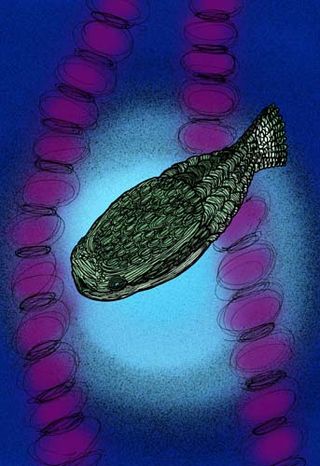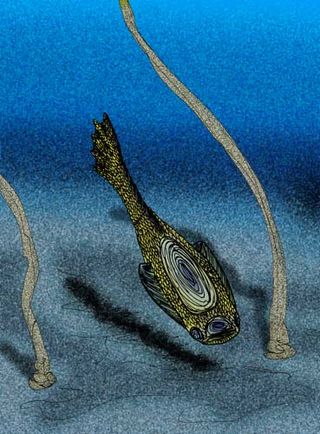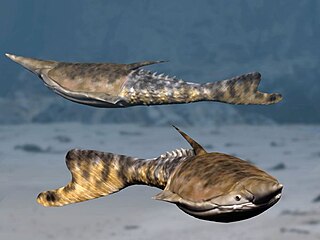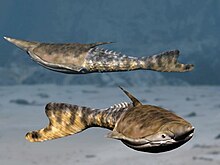
Heterostraci is an extinct subclass of pteraspidomorph jawless vertebrate that lived primarily in marine and estuary environments. Heterostraci existed from the mid-Ordovician to the conclusion of the Devonian.

Tolypelepidida is an extinct order of heterostracan vertebrates. These armored jawless fish superficially resemble their relatives, the cyathaspids, though, researchers place the tolypelepids as a sister group to the cyathaspids and the pteraspidids. A recent study by Lundgren and Blom in 2013 implies that the order is paraphyletic, with the type genus, Tolypelepis, being the sister taxon of Cyathaspidiformes. The typical tolypelepid had a carapace formed from dorsal and ventral plates, and a scaly tail.

Protaspididae is an extinct family of pteraspidid heterostracan agnathans. Fossils of the various genera are found in early Devonian-aged marine strata. Protaspidids were once thought to represent a transitional form between the Pteraspididae and the Psammosteida, bearing the broad head shield shape of the latter, due to a more benthic (bottom-dwelling) existence, but recent phylogenical comparisons demonstrate that the protaspidids are actually highly derived pteraspidids, and that the anchipteraspidids, the most primitive of pteraspidids, are the sister-group of the Psammosteids.

Pteraspis is an extinct genus of pteraspidid heterostracan agnathan vertebrate that lived from the Lochkovian to Eifelian epochs of the Devonian period in what is now Brazil, Britain, Ukraine and Belgium.

Drepanaspis is an extinct genus of primitive jawless Ostracoderms from the Early Devonian that belonged to the phylum Chordata, infraphylum Agnatha, class Pteraspidomorphi, and the subclass Heterostraci. Drepanaspis are assumed to have lived primarily in marine environments and is most commonly characterized by their ray-like, heavily armored bodies, along with their lack of paired fins and jaws.

Traquairaspis is a genus of extinct heterostracan agnathan fish known from the Silurian and Early Devonian periods. It is predominantly known from Late Silurian fluvial deposits from Wales and England: some species were also found in shallow water marine environment in Canada and North America.
Palanasaspis chekhivensis is an extinct species of pteraspidid heterostracan agnathan which existed during the Pragian epoch of the early Devonian period in what is now Podolia, Ukraine. It is known primarily from a wide rostral plate, which is referenced in the generic name, a compound word combining the Latin words pala, "shovel," and nasus, "nose," with the Greek suffix aspis, "a small shield." Although the rostral plate clearly marks the creature as a pteraspidoid heterostracan, that literally nothing else of its anatomy is known forces researchers to leave it as incertae sedis.

Psammosteida also called as Psammosteoidei is a suborder of pteraspidid heterostracan agnathans. The psammosteids had broad, flattened bodies, suggesting a predominantly benthic habit. The earliest unequivocal psammosteid is Drepanaspis of Early Devonian Germany, which is either included in the family Psammosteidae, or placed within its own family, Drepanaspididae. If the late Silurian/Early Devonian Weigeltaspis is a psammosteid, as opposed to being a traquairaspid, then that genus, instead, would be the oldest psammosteid. However, its placement within Heterostraci remains a matter of debate. Other notable psammosteids include Psammosteus, and Obruchevia, two genera of enormous species with dorsal shields around one meter in diameter. The Psammosteids were the only heterostracans to survive to the end of the Devonian, where they finally perish during the Hangenberg event.

Cardipeltis is an extinct genus of heterostracan agnathan from marine strata of early Devonian of Utah, and Wyoming. Species of Cardipeltis superficially resemble those of cyathaspids in having a flattened body and indistinct head covered by a large, broad, guitar pick or heart-shaped dorsal shield, and a long, scaly tail. Unlike cyathaspids, which all have a single ventral plate, however, the ventral shield of Cardipeltis is a mosaic composed of large scales.

Cyathaspidiformes is an extinct order of heterostracan vertebrates known from extensive fossil remains primarily from Silurian to Early Devonian strata of Europe, and North America, and from Early Devonian marine strata of Siberia.

Amphiaspidida is a taxon of extinct cyathaspidid heterostracan agnathans whose fossils are restricted to Lower Devonian marine strata of Siberia near the Taimyr Peninsula. Some authorities treat it as a suborder of Cyathaspidiformes, while others treat it as an order in its own right as "Amphiaspidiformes." In life, they are thought to be benthic animals that lived most of their lives mostly buried in the sediment of a series of hypersaline lagoons. Amphiaspids are easily distinguished from other heterostracans in that all of the plates of the cephalothorax armor are fused into a single, muff-like unit, so that the forebody of the living animal would have looked like a potpie or a hot waterbottle with a pair of small, or degenerated eyes sometimes flanked by preorbital openings, a pair of branchial openings for exhaling, and a simple, slit-like, or tube-like mouth.

Amphiaspidoidei is a taxon of extinct amphiaspidid heterostracan agnathans whose fossils are restricted to Lower Devonian marine strata of Siberia near the Taimyr Peninsula. In life, the amphiaspidids of Amphiaspidoidei are thought to be benthic animals that lived most of their lives mostly buried in the sediment of a series of hypersaline lagoons. Amphiaspids are easily distinguished from other heterostracans in that all of the plates of the cephalothorax armor are fused into a single, muff-like unit, so that the forebody of the living animal would have looked like a potpie or a hot waterbottle with a pair of small, or degenerated eyes flanked by preorbital openings, a pair of branchial openings for exhaling, and a simple, slit-like mouth.

Olbiaspididae is a family of extinct amphiaspidid heterostracan agnathans whose fossils are restricted to Lower Devonian marine strata of Siberia near the Taimyr Peninsula. In life, all amphiaspidids are thought to be benthic animals that lived most of their lives mostly buried in the sediment of a series of hypersaline lagoons. Amphiaspids are easily distinguished from other heterostracans in that all of the plates of the cephalothoracic armor are fused into a single, muff-like unit, so that the forebody of the living animal would have looked, in the case of olbiaspidids, vaguely like a hot water bottle with a pair of small, or degenerated eyes, with each flanked by a preorbital opening, and a simple, slit-like mouth positioned at the anteriormost portion of the cephalothoracic armor.

Weigeltaspis is a genus of extinct heterostracan agnathan fish known from the Late Silurian and Early Devonian periods. Fossils are known primarily from Early Devonian-aged marine strata of Europe and Canada. Fragments and disarticulated plates of what may be of Weigeltaspis are known from Late Silurian-aged marine strata of Arctic Canada. Rare articulated fossils, plus the overall anatomy of its plates suggest the living animals were, at least superficially, similar to psammosteids, some authorities, such as Tarlo, place them within Psammosteida. Because the ornamentation on the plates and scales are very similar to the ornamentation seen on the plates and scales of Traquairaspis to the point of constant confusion, other authorities follow the lead of Obruchev, and place Weigeltaspis within Traquairaspidiformes. Still other authorities remain unconvinced of either side, and, instead, follow Denison's lead to simply treat Weigeltaspis as incertae sedis.

Cyathaspidida is a taxon of extinct cyathaspidiform heterostracan agnathans whose fossils are found in Silurian to Lower Devonian marine strata of Europe and North America. In life, they are thought to be benthic animals that lived most of their lives either mostly buried in or resting directly on top of the substrate.

Anglaspis is an extinct genus of cyathaspidiform heterostracan agnathan. Fossils are found in marine strata of Europe, from the late Silurian period until the genus' extinction during the Early Devonian. As with other cyathaspidiforms, individuals of Anglaspis had dorsal and ventral plates covering the forebody, gill pouches, and nasal openings that lay on the roof of the oral cavity.

Traquairaspidiformes is an order of extinct heterostracan agnathan fish known from the Silurian and Early Devonian periods. Fossils are predominantly known from Late Silurian fluvial deposits from Wales and England: some species were also found in strata representing shallow water marine environment in Canada and North America.

Protopteraspididae is an extinct family of pteraspidid heterostracan agnathans. Fossils of the various genera are found in early Devonian-aged marine strata. Protopteraspidids were once thought to represent a taxon of basal pteraspidids but recent evaluations demonstrate that Protopteraspididae is a paraphyletic group of various transitional forms representing a gradual transition between the more advanced Pteraspoidei, and the anchipteraspidids and the Psammosteids.

Pteraspididae is an extinct family of heterostracan vertebrates. It is an Early Devonian-aged family that contains the stereotypical, torpedo-shaped pteraspidids, such as the type genus, Pteraspis, and its close relatives Errivaspis and Rhinopteraspis, that are popularly thought to have actively swam about in the water column. The elongated rostral plate is thought to help with their hydrodynamic ability. Various genera are found in various marine and estuarine strata of Early Devonian Europe and North America.
Anchipteraspididae is an extinct family of heterostracan vertebrates restricted to Late Silurian and Early Devonian strata of Arctic Canada.






















